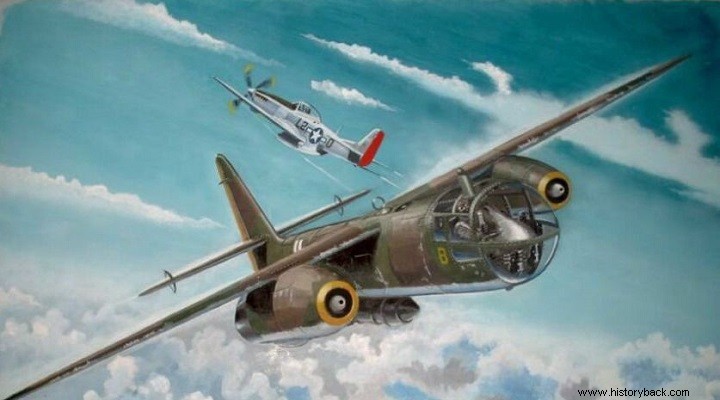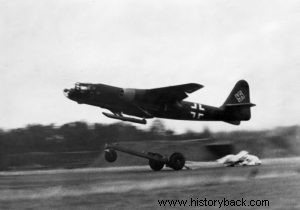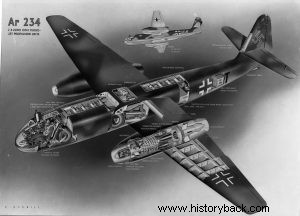
Germany was one of the pioneers in jet aircraft technology. In the fall of 1940 the Air Ministry issued a specification for a high-speed, long-range jet-powered aircraft. Of all the German aircraft manufacturers, only Arado responded.
Arado presented the E.370 design which was a twin-engine jet aircraft with Jumo 004 engines. Based on the designs the aircraft had a range of almost 2,000 km which was slightly below the ministry's specifications.
Despite this, the ministry ordered two prototypes. The new aircraft received the name Arado Ar 234. The great advantage of the aircraft was its advanced, for the time, engines, created by Dr. Anselm Franz. But the engines also became the Achilles heel of the aircraft as problems in their development resulted in the aircraft flying for the first time only on July 30, 1943.
The first five Ar 234 prototypes (V1 – V5) all carried Jumo engines. However, two prototypes with four BMW 003 jet engines were soon presented. On 2 August 1944 the V7 prototype with Jumo engines flew the first combat reconnaissance mission piloted by Erich Sommer.
The aircraft did not have a permanent landing gear. It took off with the help of a tricycle wheel system and landed with retractable skis. This fact made the take-off time-consuming and the landing dangerous.
Soon there were thoughts of developing a prototype bomber as well. This was the Ar 234B which had a larger fuselage and normal landing gear. Consequently it was heavier and slower than the ID. It could carry up to 1,500 kg of bombs. On the prototypes, two remote-controlled 20mm cannons were placed under the fixed vertical, but these were apparently not used on the operational aircraft which, due to speed, did not need defensive armament.
Operational action
On its first reconnaissance mission the Ar 234 flew over Normandy at a speed of 740 kilometers per hour (h.a.o.) and returned with precious photos.
The Ar 234B bomber became famous for its attacks on the Remagen bridge which the Americans caught by surprise. The bombers operated as part of the KG 76 Fighter Wing which came to have 51 aircraft of the type.
These were initially supplied to III/KG 76 and used in bombing missions in Belgium, France and the Netherlands. On 24 December the Ar 234s carried out a rather daring attack on Namur railway station in Belgium where the Battle of the Bulge was raging. Raids on Liège and Bastogne followed.
However, the unit also carried out reconnaissance missions in the port of Antwerp, while on January 20, 1945 Ar 234s attacked the same port. The raid was repeated on 24 January. On February 8, targets in the Brussels area were hit and on February 21 allied gatherings in Eindhoven, Holland.
The attacks on the Ludentrop bridge at Remagen took place between 9 and 13 March 1945 and caused the unit's heaviest losses from heavy anti-aircraft fire. On March 21, however, the Allies bombed the Ar 234 base, destroying 10 and damaging another eight on the ground.
In April 1945 the unit was left with seven operational aircraft and another four under repair and 16 combat-ready pilots. On April 10, however, the unit was reinforced with five more aircraft. The unit continued to fight throughout April 1945 hitting mainly the Allied forces advancing on German soil. The last mission was executed on May 3, 1945.

Identifier Ar 234 takes off with the help of the tricycle system.

